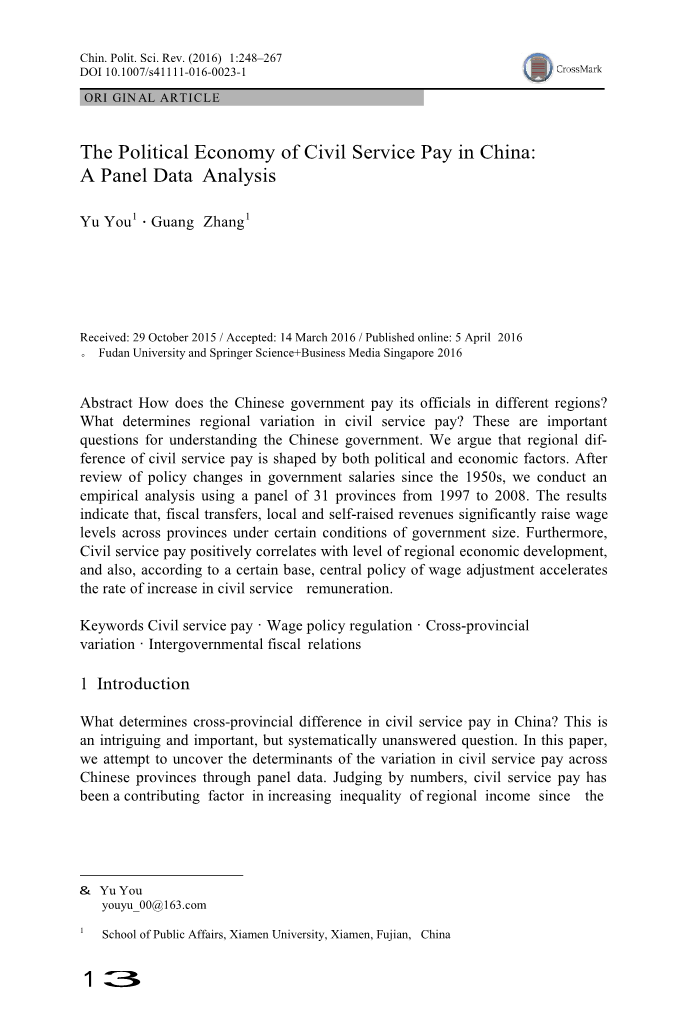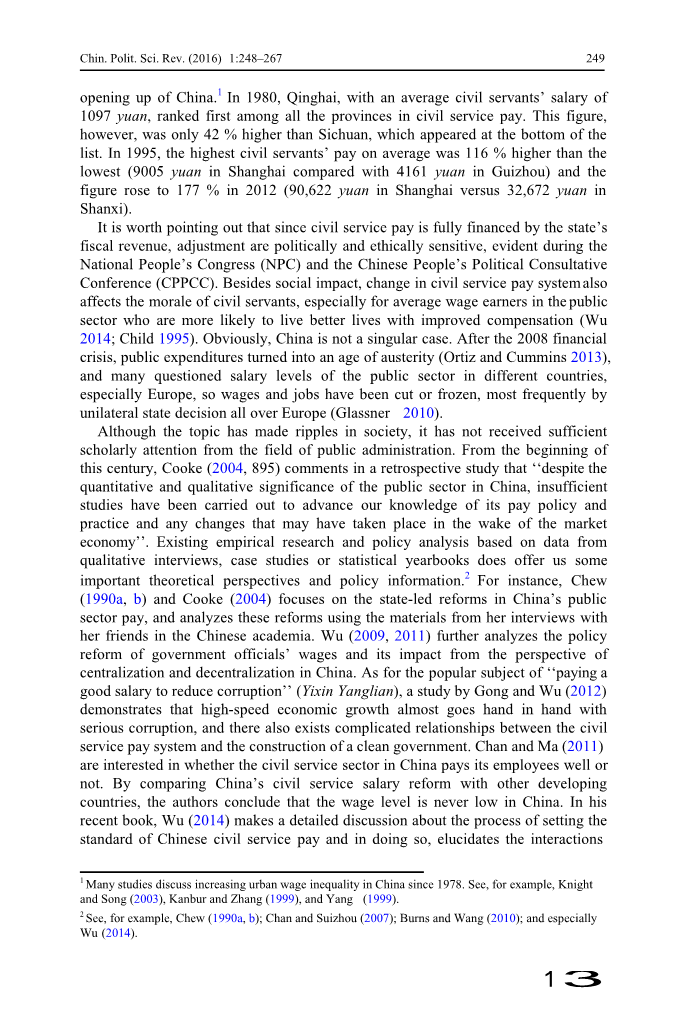

英语原文共 21 页,剩余内容已隐藏,支付完成后下载完整资料
The Political Economy of Civil Service Pay in China: A Panel Data Analysis
DOI 10.1007/s41111-016-0023-1 ORI GIN AL ARTICLE
Yu You1 bull; Guang Zhang1
Received: 29 October 2015 / Accepted: 14 March 2016 / Published online: 5 April 2016
。 Fudan University and Springer Science Business Media Singapore 2016
Abstract How does the Chinese government pay its officials in different regions? What determines regional variation in civil service pay? These are important questions for understanding the Chinese government. We argue that regional dif- ference of civil service pay is shaped by both political and economic factors. After review of policy changes in government salaries since the 1950s, we conduct an empirical analysis using a panel of 31 provinces from 1997 to 2008. The results indicate that, fiscal transfers, local and self-raised revenues significantly raise wage levels across provinces under certain conditions of government size. Furthermore, Civil service pay positively correlates with level of regional economic development, and also, according to a certain base, central policy of wage adjustment accelerates the rate of increase in civil service remuneration.
Keywords Civil service pay · Wage policy regulation · Cross-provincial variation · Intergovernmental fiscal relations
Introduction
What determines cross-provincial difference in civil service pay in China? This is an intriguing and important, but systematically unanswered question. In this paper, we attempt to uncover the determinants of the variation in civil service pay across Chinese provinces through panel data. Judging by numbers, civil service pay has been a contributing factor in increasing inequality of regional income since the
amp; Yu You
1 School of Public Affairs, Xiamen University, Xiamen, Fujian, China
opening up of China.1 In 1980, Qinghai, with an average civil servantsrsquo; salary of 1097 yuan, ranked first among all the provinces in civil service pay. This figure, however, was only 42 % higher than Sichuan, which appeared at the bottom of the list. In 1995, the highest civil servantsrsquo; pay on average was 116 % higher than the lowest (9005 yuan in Shanghai compared with 4161 yuan in Guizhou) and the figure rose to 177 % in 2012 (90,622 yuan in Shanghai versus 32,672 yuan in Shanxi).
It is worth pointing out that since civil service pay is fully financed by the statersquo;s fiscal revenue, adjustment are politically and ethically sensitive, evident during the National Peoplersquo;s Congress (NPC) and the Chinese Peoplersquo;s Political Consultative Conference (CPPCC). Besides social impact, change in civil service pay system also affects the morale of civil servants, especially for average wage earners in the public sector who are more likely to live better lives with improved compensation (Wu 2014; Child 1995). Obviously, China is not a singular case. After the 2008 financial crisis, public expenditures turned into an age of austerity (Ortiz and Cummins 2013), and many questioned salary levels of the public sector in different countries, especially Europe, so wages and jobs have been cut or frozen, most frequently by unilateral state decision all over Europe (Glassner 2010).
Although the topic has made ripples in society, it has not received sufficient scholarly attention from the field of public administration. From the beginning of this century, Cooke (2004, 895) comments in a retrospective study that lsquo;lsquo;despite the quantitative and qualitative significance of the public sector in China, insufficient studies have been carried out to advance our knowledge of its pay policy and practice and any changes that may have taken place in the wake of the market economyrsquo;rsquo;. Existing empirical research and policy analysis based on data from qualitative interviews, case studies or statistical yearbooks does offer us some important theoretical perspectives and policy information.2 For instance, Chew (1990a, b) and Cooke (2004) focuses on the state-led reforms in Chinarsquo;s public sector pay, and analyzes these reforms using the materials from her interviews with her friends in the Chinese academia. Wu (2009, 2011) further analyzes the policy reform of government officialsrsquo; wages and its impact from the perspective of centralization and decentralization in China. As for the popular subject of lsquo;lsquo;paying a good salary to reduce corruptionrsquo;rsquo; (Yixin Yanglian), a study by Gong and Wu (2012) demonstrates that high-speed economic growth almost goes hand in hand with serious corruption, and there also exists complicated relationships between the civil service pay system and the construction of a clean government. Chan and Ma (2011)
are interested in whether the civil service sector in China pays its employees well or not. By comparing Chinarsquo;s civil service salary reform with other developing countries, the authors conclude that the wage level is never low in China. In his recent book, Wu (2014) makes a detailed discussion about the process of setting the standard of Chinese civil service pay and in doing so, elucidates the interactions
1 Many studies discuss increasing urban wage inequality in China since 1978. See, for example, Knight and Song (2003), Kanbur and Zhang (lt;
全文共75204字,剩余内容已隐藏,支付完成后下载完整资料
资料编号:[450336],资料为PDF文档或Word文档,PDF文档可免费转换为Word
您可能感兴趣的文章
- 薪酬满意度作为工作满意度的先行因素:建立一个回归模型,确定公共和私人组织中薪酬满意度与工作满意度之间的线性关系外文翻译资料
- 胜任力与胜任力、胜任力模型与胜任力模型的比较研究外文翻译资料
- 如何提高企业网络招聘的有效性外文翻译资料
- 为初级职位招聘大学生,在制定战略和战术校园招聘计划时,需要考虑哪些问题?外文翻译资料
- 基于能力的招聘:招聘和留住成功员工的关键外文翻译资料
- 员工培训对体育门票销售人员工作满意度的影响外文翻译资料
- 由雇主参与的创新型员工激励模式外文翻译资料
- 浅析企业文化与企业绩效的相关性 ——以苏州金色未来信息咨询股份有限公司为例外文翻译资料
- 互联网背景下基于平衡计分卡的计算机绩效评价系统外文翻译资料
- 提高斯洛伐克公共行政部门招聘过程的效率外文翻译资料


